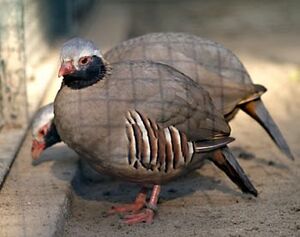Philby's partridge facts for kids
Quick facts for kids Philby's partridge |
|
|---|---|
 |
|
| Conservation status | |
| Scientific classification | |
| Genus: |
Alectoris
|
| Species: |
philbyi
|
The Philby's partridge (Alectoris philbyi), also known as the Philby's rock partridge, is a fascinating bird. It is a type of partridge that lives in the rocky areas of southwestern Saudi Arabia and northern Yemen. This bird is related to other well-known partridges like the chukar, red-legged partridge, and barbary partridge.
Even though it looks a lot like its relatives, you can spot a Philby's partridge by its unique black cheeks and throat. This special bird was named after a British explorer called St John Philby. While it is not currently in danger of disappearing, people are keeping an eye on its habitat. They want to make sure this beautiful bird continues to thrive in its natural home.
Contents
What Does Philby's Partridge Look Like?
Philby's partridge is a medium-sized bird with a special look. It has feathers that are mostly grayish-brown. Its sides, called flanks, have bold stripes of black and a pale, creamy color.
Key Features of Philby's Partridge
What really makes this partridge stand out are its black cheeks and throat. A thin white line separates these black areas from its grayish-blue head and the back of its neck. Its beak and legs are a bright pink color, adding a splash of color to its appearance.
Where Philby's Partridge Lives
This interesting bird makes its home in two countries: Saudi Arabia and Yemen. It prefers to live on rocky slopes and in areas where there isn't a lot of plants growing.
Philby's Partridge Habitat
You can usually find Philby's partridge living at high altitudes. They live in places that are typically between 4,500 and 9,000 feet (about 1,370 to 2,740 meters) above sea level. These rocky, open areas provide the perfect environment for them.
How Philby's Partridge Behaves
Philby's partridge is a ground-dwelling bird, meaning it spends most of its time on the ground. It is always looking for food and raising its young there.
What Philby's Partridge Eats
This partridge enjoys a varied diet. It mainly eats seeds and other parts of plants. It also likes to snack on small invertebrates, which are tiny creatures without backbones, like insects.
Reproduction and Life Cycle
The breeding season for Philby's partridge happens from April to June. During this time, the female bird lays her eggs in a nest built on the ground. A typical clutch has about five to eight eggs. These eggs are a pale, creamy color with small pink spots. The mother bird sits on the eggs to keep them warm for about 25 days until they hatch.
Philby's Partridge and People
Philby's partridge is not a very common bird, so it's not usually a main food source for people. However, it is sometimes kept by bird enthusiasts.
Philby's Partridge in Aviculture
Aviculture is the hobby of keeping and breeding birds. Philby's partridge was brought to the United States in the 1980s. Since then, it has become quite common among people who enjoy keeping birds.
Conservation Status
The International Union for Conservation of Nature (IUCN) is an organization that checks on the health of animal populations around the world. They have listed Philby's partridge as a species of "least concern". This means that the bird has a wide area where it lives and is thought to have a large total population. So, for now, it is not considered to be in danger.


